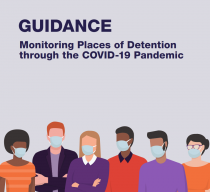4th June 2020
 With increased restrictions due to COVID-19 in place in most places of detention, people deprived of their liberty are at high risk of contracting COVID-19 and of ill-treatment. National Preventive Mechanisms (NPMs), who undertake monitoring of places of detention in line with the Optional Protocol to the Convention against Torture (OPCAT), are facing challenges in continuing their vital work. This guidance document aims to help NPMs to continue operating under these conditions, and includes examples from different NPMs internationally. While guidance has been provided by many international bodies (see collated resources here) this guidance document is structured in practical terms.
With increased restrictions due to COVID-19 in place in most places of detention, people deprived of their liberty are at high risk of contracting COVID-19 and of ill-treatment. National Preventive Mechanisms (NPMs), who undertake monitoring of places of detention in line with the Optional Protocol to the Convention against Torture (OPCAT), are facing challenges in continuing their vital work. This guidance document aims to help NPMs to continue operating under these conditions, and includes examples from different NPMs internationally. While guidance has been provided by many international bodies (see collated resources here) this guidance document is structured in practical terms.
The role of NPMs during the pandemic
The guide encourages NPMs to use this opportunity to explore the full scope of their mandate. NPMs do not exist only to visit places of detention, but also to gather and analyse information, to engage in dialogue with authorities and to comment on and recommend legislation and policy. NPMs should continue this work to assist in the handling of the COVID-19 crisis and push for improved transparency and accountability. There is also an opportunity to address systemic issues that have come to the fore during the pandemic such as overcrowding and pre-trial detention.
Monitoring during COVID-19
On top of advocacy work, monitoring must also continue through methods of remote monitoring and, if possible, adapted on-site visits. Most NPMs have suspended on-site visits, due to fears of bringing the coronavirus into prisons and protecting NPM staff, due to a lack of PPE and poor hygiene conditions in prisons. However, remote monitoring and data collection is still possible. Some ways of keeping in contact with detainees include through telephone hotlines in prisons, email and letters. However, NPMs must be conscious of safeguarding detainees as confidentiality may be harder to enforce remotely. For NPMs who are continuing to visit places of deprivation of liberty it is important to prepare well for the visit. This includes defining specific objectives of each visit, acquiring protection, monitoring visitors for COVID-19 symptoms before the visit, and considering reducing the size of the visiting team and duration of the visit. During the visit, it may not be advisable to visit all parts of the prison, but monitors could ask for video footage of areas they cannot reach. They could also prioritize visiting those detained in quarantine or isolation areas as they face the most severe restrictions. If interviews are conducted, care should be taken to maintain the appropriate distance between people.
New risks and challenges
Two of the new risks and challenges identified by the guidance are:
The nature of this pandemic represents a unique opportunity for NPMs from across the globe to exchange promising practices and learn from each other. The current situation has also brought advocacy opportunities for NPMs and openings for constructive dialogue with the relevant authorities. NPMs have an opportunity to ensure that innovating new progressive practices are retained, and that the current situation has a positive effect on the condition of persons deprived of liberty.
Read the guidance by the APT and OSCE/ODIHR here.




Respect for rights in the penal system with prison as a last resort.